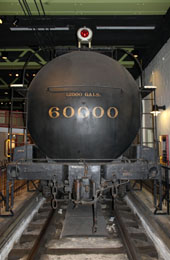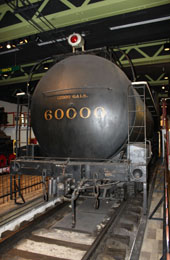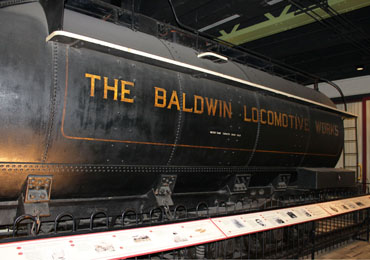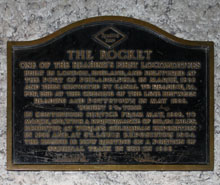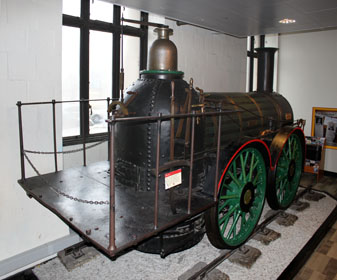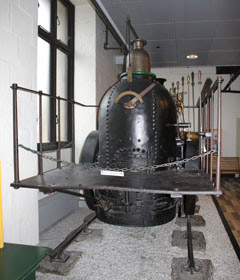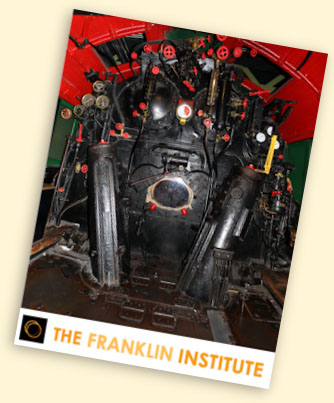

The Franklin Institute, at the intersection of 20th St and Benjamin Franklin Parkway in Philadelphia, PA, is one of the oldest scientific institutes in the US. It is open 9.30am-5.00pm daily except New Year's Day, Thanksgiving, Christmas Eve, Christmas Day and Franklin Awards Day.
The Science Museum is the best known part of the Institute. It includes an IMAX cinema, planetarium and many exhibition halls. Among these, "The Train Factory" houses three steam locomotives, the
most impressive of which is the Baldwin #60000.
"The Train Factory" is very popular and sees lots of school party visitors, so get there early if you want good photos of the locomotives!

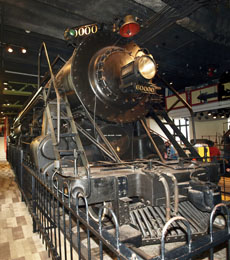
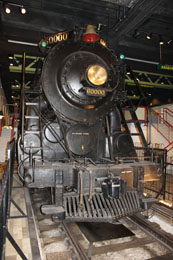
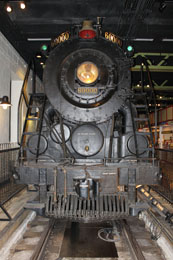
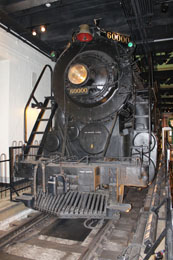

#60000 was outshopped in August 1926. It was the 60,000th locomotive built by Baldwin, hence its number, and was designed to test the potential benefits of high steam pressure and a high ratio of expansion in steam locomotives.
It has a 4-10-2 wheel arrangement with 63½" driving wheels and three 27" x 32" cylinders each with 14" pistons. The internal cylinder was the high pressure cylinder (the head is directly above the middle of the pilot, the steam chest is to the left). This took steam from the boiler first and then expended the used steam at a reduced pressure to two low pressure cylinders on each side of the frame.
#60000 was a coal burner. Its boiler barrel is a conventional wagon top, 84" in diameter with 206 x 2¼" firetubes and 50 x 5½" fire tubes housing type A superheater elements. However, a watertube section surrounds the firebox with fifty 4" tubes on each side running from a cast steel mud ring at the bottom to one of two horizontal steam drums at the top. The 26" diameter steam drums are 26' 6" in length and extend 5' 6" into the boiler barrel. Their cover plates sit in the backhead.
The firebox is 745 sq ft, with a grate area of 82½ sq ft. The sides, front and back of the firebox, as well as the gap between the two steam drums, were all covered with firebrick, which gave #60000 a total heating area of 5,192 sq ft. The locomotive was fired by a Duplex stoker and operated at a boiler pressure of 350 psi.
The tender is of the Vanderbilt type carried on two six-wheeled trucks. It is has capacity of 12,000 gallons of water and 16 tons of coal.
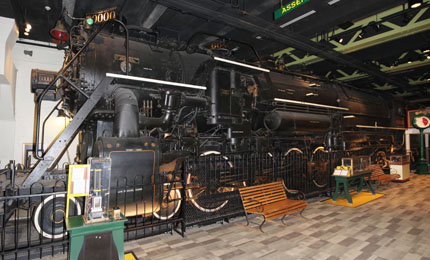

The locomotive and tender are 86' 11¼" long (total wheelbase) and together weigh 700,900 lbs light (457,500 lbs engine / 243,400 lbs tender). #60000 has a Worthington feedwater heater mounted on the left side of the boiler.
The main and side rods are made of carbon vanadium steel. The driving axles, main crank pins and piston rods are
made of open hearth steel, heat-treated, oil quenched and hollow bored. The high pressure piston is connected to an offset crank on the second pair of driving wheels. The two low pressure pistons are connected to the third pair of drivers. The two outside cranks are placed 90° apart to deliver four even exhausts per revolution. The inside crank is placed at 135° from each outside crank. All ten drivers on the 22' 10" long engine wheel base are flanged. Lateral
motion boxes are fitted to the first driving axle, and the front truck has a swing bolster, while the rear truck is of the Delta type. There is a continuous equalisation system on each side of the locomotive from the leading drivers to the rear truck.
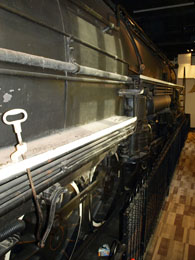
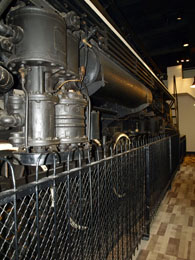

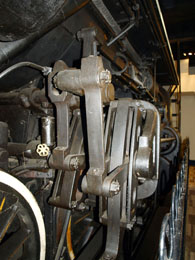
Air pumps are mounted on the right side as well as the left. The locomotive has Walschaert gears.

There is a hydraulically-powered 15' "ride" in the cab (wisps of artificial steam and smoke thrown in) and...

...it's worth it to see #60000's impressive backhead!
So, how did #60000 perform?
At the Pennsy's Altoona testing facility in August and September 1926, #60000 performed very well, registering 4,515 hp, the highest in the test bed's history. The maximum firing rate was 150 lbs of coal per sq ft of grate per hour, equal to 12,388 lbs of coal per hour, delivering 51% boiler efficiency, and the locomotive delivered a tractive effort of 82,500 lbs. A promising start...
After Altoona, #60000 was tested on several railroads, including the Pennsy, Baltimore & Ohio, Erie, Chicago, Burlington & Quincy and Santa Fe.
In mid 1927, the locomotive was converted to burn oil on the Southern Pacific, although it apparently did not do too well on tests over Donner Pass. After returning east, it was then converted back to burn coal for tests on the Great Northern in late 1927.
The "Baldwin Boomer" covered 100,000 miles as a demonstrator as well as appearing on static
display at Chicago's Union Station, and in
Portland, OR, but it was clear that the economies gained by high pressure and compounding came
at too great a price in terms of maintenance and reliability. The drivers' axle loadings were also too great for much of the existing railroad track, and
its demonstration runs never persuaded any railroad company to purchase a production locomotive.
After returning to Eddystone in February 1928, #60000 went on no more demonstration runs. Instead, it was used as a stationary power source at Baldwin's works for a period and then, in 1933, was sold to the Franklin Institute for $1.00. Handlers rolled #60000 into what was then known as the "Railroad Hall" on makeshift tracks through what would later become the Science Museum's northwest wall. The tracks run back to the inside of the wall to this very day.

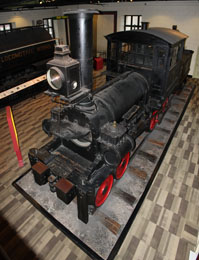
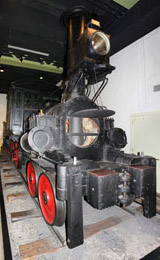
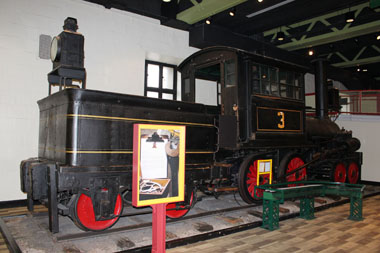
Philadelphia & Reading #3 was built by the Philadelphia company Eastwick & Harrison in 1842. An American type (4-4-0), it is typical of this small company's limited production: they built no more than twenty locomotives between 1838 and 1844.
It is a coal burner with 42½" drivers and 12¾" x 18" cylinders. It initially operated on a branch of the Reading called the "People's Railway" hauling freight and passengers between Pottsville and Minersville, PA. It was then a switcher in Reading, PA. In the late 1800s, it was rescued from the dead line and preserved because of its venerable age.

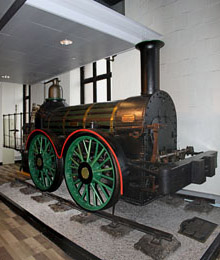
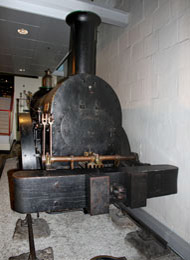
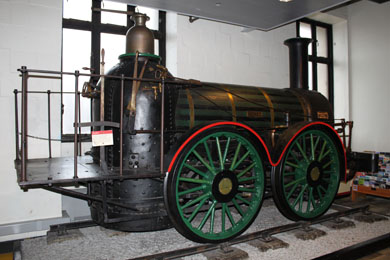
"The Rocket" was a coal burner. It is 17' long and 6' 8" high, weighs 26,550 lbs, has 49" drivers and 10½" x 16" cylinders set just inside the front drivers.
The locomotive arrived in Philadelphia in March 1838 and was taken to Reading by canal boat. It then served on the Reading to Pottstown section of the railroad for forty-one years, clocking up 310,164 miles. Retired in 1879, "The Rocket" came out of retirement in 1893 for the Chicago World's Columbian Exposition. It was also shown at the St. Louis Exposition in 1904 and the Fair of the Iron Horse in 1927. It then went on display at the Reading Terminal, at 12th and Market Streets in Philadelphia, PA, and was donated to the museum in 1933.
Above, the plaque at the foot of this display marks "The Rocket" as one of the first locomotives purchased by Reading Lines.
It is an 0-4-0 type built by Braithwaite, Milner & Co., in London, England, a short lived producer of steam locomotives. The majority of their output went to the Eastern Counties Railway in England or was exported to US railroads, particularly the Philadelphia & Reading.






